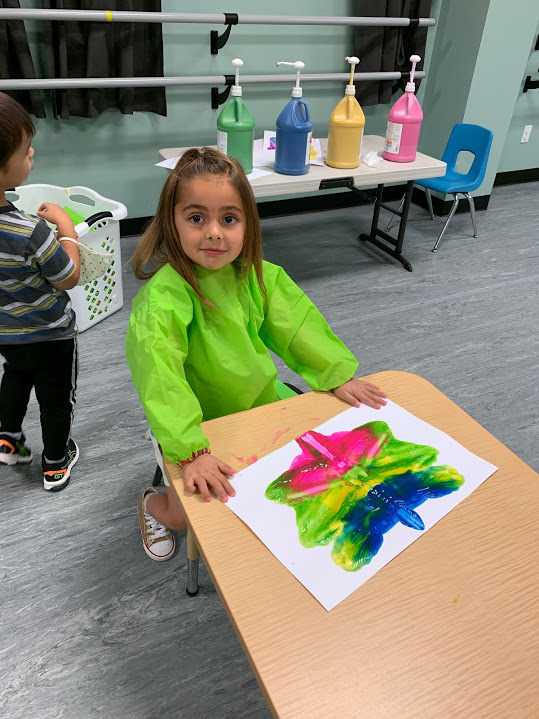At UDA Creative Arts Preschool, art features heavily into every day of school. This isn’t just because art is fun (although, it definitely is!), but because when children are free to express themselves artistically, they develop in critical ways.
One key element in successful preschool art is how the ADULT behaves. It’s critical for the adult to:
Step. Back.
When adults give artistic opportunities — and refrain from intervening — kids thrive.
Read on for the benefits of art — and why you shouldn’t control it.
Experience
Preschoolers need to experience the world in a variety of ways. Art allows them to get in the moment, feeling their emotions right along with the senses that are activated when creating art.
Letting your child feel the smoothness of the paint as it glides across the paper is more important than what the end product looks like.
Sit back and watch your child create. You’ll notice they’re fully immersed in the experience of the art. They aren’t self-conscious or worried about the end product. This is a gift — to be able to experiment and enjoy the process.
Health and Well-Being
Children who have experience expressing themselves freely know how to learn. They know how to soothe themselves when they are stressed. And they know how to work through difficult things.
Freedom in art can give your children practice developing coping skills, learning skills, and even grit.
Other Benefits of Self-Expression in Preschool Art
Art has been shown to build analyzing and problem-solving skills. It teaches cause-and-effect, and even basic math as children count and add elements .
Children build fine-motor skills as they manipulate the art instruments.
Perhaps most importantly, children who are free to experiment in their art get comfortable with making mistakes — and even improving mistakes. And this allows them to attempt new skills in other areas of their life, even opening their minds to new ways of thinking.
What It Looks Like to Let Go
Letting go is hard for many parents, and it makes sense! We’re a results-driven society. It can be hard to feel like your child is getting anything out of the activity if all they’re doing is scribbling over the page.
If you struggle with this, remind yourself that children learn as they play. Your child may be releasing stress while scribbling. They may be building focus as their mind imagines. Maybe they enjoy watching what happens as more color fills the page. They may like the feel of the vibrations as their crayon moves faster and faster.
And they may not be able to tell you any of this. Trust that they are learning and developing as they are free to explore art on their own terms.
Process Over Product
Sure, you might have an idea of what the end result is supposed to look like. But when your child is creating art, step back and let them focus on the process.
If they feel bound to an end result, not only will their creativity be stifled, they may learn to create for approval rather than enjoyment in the activity.
Encourage effort and exploration as your child creates.
A Few Rules for the Adult
If you watch us in our classrooms at UDA Creative Arts Preschool, you’ll see that we don’t intervene in our children’s art projects. We don’t want to take away their own artistry, and we know it’s important for children to own their art.
As a result, no two projects ever look the same.
And that’s the way it’s supposed to be.
Keep these six rules for YOU in mind:
How to Support Your Child’s Art
- First, don’t give direction. Don’t tell your child how to draw a house. If they choose to draw a house, let them add any element they wish.
- Don’t intervene. Certainly, if your child needs help with sharpening a crayon, you can guide them. But don’t intervene in the artistic process. It may be tempting to say, “A rabbit has TWO ears, remember?” Hold your tongue, and let them draw however many ears they want.
- Encourage experimentation. It’s fun to mix colors or use different materials together. Allow, and encourage, this to happen.
- Talk about the art. Your child will hold up their painting, looking for your approval. A generic compliment won’t be encouraging — remember, the final product isn’t the point. Instead, take that opportunity to ask specific questions that allow your child to discuss their artwork. “I notice you used every color in your crayon box. Why did you choose all of them?”
- Encourage process. Use questions that encourage your child to talk about their process. “Did you enjoy making this painting?”
- Don’t criticize, or suggest additions or removals of any element. Don’t tell them they could have done a better job. Accept whatever they create.
At UDA Creative Arts Preschool in Draper, Utah, we know how important art is for your child’s intellectual, physical, and emotional development. To learn more about how we teach, contact us online or give us a call at (801) 523-5930.



